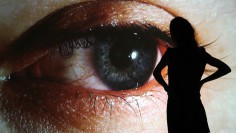Rafael Lozano-Hemmer
РАФАЭЛЬ ЛОЗАНО-ХЕММЕР
拉斐尔·洛萨诺 – 亨默
ラファエル·ロサノ=ヘメル
라파엘 로자노
רפאל לוזאנו, המר
Surface Tension

source: lozano-hemmer
“Surface Tension” is an interactive installation where an image of a giant human eye follows the observer with orwellian precision.This work was inspired by a reading of Georges Bataille’s text The Solar Anus during the first Gulf War: first wide-spread deployment of camera-guided “intelligent bombs”. Present-day computerised surveillance techniques employed by the Department of Homeland Security in the United States through the Patriot Act, provide a new and distressing backdrop for this piece.
The installation was originally developed in 1992 at the Universidad Complutense de Madrid as a stage module for a theatre work by the Transition State Theory troupe. Since then, Surface Tension has been presented as an art installation, typically on a plasma screen.
.
.
.
.
.
.
.
source: bitforms
An installation with several interactive modules. Originally designed for a technological theater by TST, the modules consist of animated photos that react to the movements of actors, dancers and the public. Currently the human eye module is shown in a plasma or retro-projection screen with a video-based tracking system that detects the public. Collaboration with Transition State Theory.
.
.
.
.
.
.
.
source: lozano-hemmer
Rafael Lozano-Hemmer was born in Mexico City in 1967. In 1989 he received a B.Sc. in Physical Chemistry from Concordia University in Montréal, Canada.
Electronic artist, develops interactive installations that are at the intersection of architecture and performance art. His main interest is in creating platforms for public participation, by perverting technologies such as robotics, computerized surveillance or telematic networks. Inspired by phantasmagoria, carnival and animatronics, his light and shadow works are “antimonuments for alien agency”.
His large-scale interactive installations have been commissioned for events such as the Millennium Celebrations in Mexico City (1999), the Cultural Capital of Europe in Rotterdam (2001), the UN World Summit of Cities in Lyon (2003), the opening of the YCAM Center in Japan (2003), the Expansion of the European Union in Dublin (2004), the memorial for the Tlatelolco Student Massacre in Mexico City (2008), the 50th Anniversary of the Guggenheim Museum in New York (2009) and the Winter Olympics in Vancouver (2010).
Recently the subject of solo exhibitions at the San Francisco Museum of Modern Art, the Fundación Telefónica in Buenos Aires and the Museum of Contemporary Art in Sydney, he was the first artist to officially represent Mexico at the Venice Biennale with a solo exhibition at Palazzo Soranzo Van Axel in 2007. He has also shown at Art Biennials and Triennials in Havana, Istanbul, Liverpool, Montréal, Moscow, New Orleans, Panama, Seville, Seoul, Shanghai, Singapore and Sydney. Collections holding his work include the MoMA in New York, Tate in London, AGO in Toronto, CIFO in Miami, Jumex in Mexico City, DAROS in Zurich, Borusan Contemporary in Istanbul, MUAC in Mexico City, 21st Century Museum of Art in Kanazawa, MAG in Manchester, MUSAC in Leon, MONA in Hobart, ZKM in Karlsruhe, MAC in Montréal and SAM in Singapore, among others.
He has received two BAFTA British Academy Awards for Interactive Art in London, a Golden Nica at the Prix Ars Electronica in Austria, “Artist of the year” Rave Award from Wired Magazine, a Rockefeller fellowship, the Trophée des Lumières in Lyon and an International Bauhaus Award in Dessau. He has lectured at Goldsmiths college, the Bartlett school, Princeton, Harvard, UC Berkeley, Cooper Union, USC, MIT MediaLab, Guggenheim Museum, LA MOCA, Netherlands Architecture Institute, Cornell, UPenn, SCAD, Danish Architecture Cente, CCA in Montreal, ICA in London and the Art Institute of Chicago.
.
.
.
.
.
.
.
source: lozano-hemmer
Homographies is a large-scale interactive installation featuring a turbulent light array that responds to the movement of the public. The installation consists of 144 white fluorescent light tubes which are hung from 72 robotic fixtures on the ceiling of the exhibition space, equally spaced. Each light tube measures 1.83 m long and is rotated using a computer-controlled stepper motor. All lights are always on and typically constitute the only lighting in the exhibition hall, except for the natural light that spills into the space.
Originally developed for the Entrance Court of the Art Gallery of New South Wales (AGNSW) and exhibited at the Sydney Biennale 2006, the piece can cover an area of between 240 and 420 square metres.
The piece uses a surveillance tracking system with six tiny panoptic cameras placed on the ceiling; these detect the presence and position of people in the exhibition space. As they walk through, the system automatically rotates the light tubes very slowly to create labyrinthine patterns of light that are “paths” or “corridors” between people. In Homographies the “vanishing point” is not architectural, but rather connective, i.e. it is determined by who is there at any given time and varies accordingly. This gives a reconfigurable light-space that is based on flow, on motion, on lines of sight, an intended contrast to the cartesian grids that organize most modern architecture.
The fluorescent light tube is found in just about any default architectural space: offices, schools, hospitals, museums, prisons, factories. The ubiquitous presence of these strip lights refer us to our cold experience of architectural normalization (i.e. homogenization, globalization). Very often, especially when found in corridors, fluorescents line-up and index a direction. Homographies attempts to pervert that linearity and “privileged point of view” and instead offer a plurality of points of contact.

